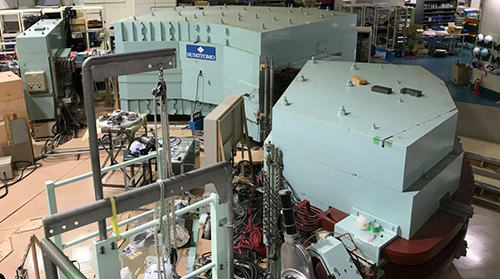Alpha particles, consisting of two protons and two neutrons but no electrons, are abundant in nature as radioactive decay products of heavy elements and familiar to us for the health risks they pose. Yet despite more than a century's-worth of investigation, where and when alpha particles form within the atomic nuclei of heavy elements, though, has remained a poorly understood process. Now new insights have come from recent experiments involving the triggering of varying alpha-particle formation rates by bombarding neutron-rich isotopes of the element tin (Sn) with high-energy proton beams. The experiments have revealed new details about the structure and distribution of protons and neutrons throughout tin nuclei. The findings should improve models of both radioactive decay and extreme cosmic objects known as neutron stars. See also: Alpha particles; Atom; Atomic nucleus; Chemical element; Helium; Neutron; Proton; Radioactivity

The physicists ran the experiments at the Research Center for Nuclear Physics in Osaka, Japan. The energetic proton beam struck targets of tin, a metallic element with 50 protons and a neutron number usually ranging from 62 to 74. Two spectrometers detected scattering protons and alpha particles knocked out of the tin nuclei by the beam's impact. The researchers measured a decrease in alpha particle yields as the mass of the tin isotope comprising the target increased (as the number of neutrons in the target increased). The observations support theories describing how an outer neutron "skin" forms around the nuclei of heavy, neutron-rich elements, wherein alpha particles can naturally preform. When the neutron skin was thicker for the heavier isotopes of tin with more neutrons, the proton beam could not as easily dislodge preformed clusters of alpha particles. Learning more about the mechanics of alpha particle formation in everyday conditions could prove helpful for a number of applications—for example, occupational safety reasons—because alpha particles are a form of ionizing radiation that damages living tissue. See also: Radiation; Radiation injury to plants and animals; Spectroscopy; Tin
The findings also will provide insight into the inner workings of neutron stars. These objects are hyperdense, city-sized remnants of massive stars in which gravity has crushed most of the available protons and electrons together into forming neutrons, resulting in a body composed almost entirely of neutrons. From a fundamental physics standpoint, neutron stars can be simplistically thought of as gigantic atomic nuclei, because the two entities possess comparable densities. Accurately modeling the asymmetrical distribution of nucleons (protons and neutrons) inside atomic nuclei will thus improve our understanding of neutron stars, which likewise should be asymmetrical in their internal particle distribution. See also: Neutron star; Nucleon





